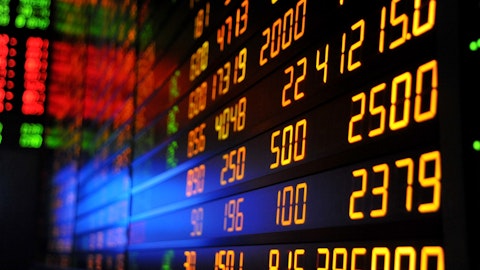One of the key aspects of building a solid portfolio is diversification. Numerous studies have shown that including a mix of various investments within a portfolio can yield higher returns over the long run and significantly reduce risk. Through diversification, a portfolio contains securities that are not perfectly correlated. In the past, diversification involved selecting a bunch of US securities across various sectors and industries.
With the ascension of online trading, the investors’ reach expanded and further diversification can be obtained by picking stocks from multiple geographies. Securities from different countries will be even less correlated, because the economic situation in one country will not be the same as in another.
The US bull market has been running for nearly a decade now and, while the rally might continue for another couple of years, the returns might not be as strong as in the past. Therefore, a good idea might be to look for investment opportunities overseas. European stocks have an optimistic outlook, and so do some emerging markets. One emerging market that is expected to perform very well is India. Indian economy has grown by 7.2% in the fiscal third quarter ended December and for the full fiscal 2017/2018, growth is expected at 6.6%.

xtock/Shutterstock.com
The IMF forecasts that, at a 7.8% growth, India will have the fastest growing economy in 2019. By comparison, Chinese economy is expected to expand at 6.4%. Over the long run, Indian economy is expected to maintain its leading position as the world’s fastest economy, outpacing China.
So, for better geographical diversification, one should consider investing in Indian stocks. There are a bunch of Indian companies listed on the US stock market as American Depository Receipts. ADRs allow investors to gain exposure to foreign companies easier than buying the foreign stock outright. Rather than looking through all Indian stocks, we focused only on those that are the most popular among smart money investors. While often hedge funds don’t buy US-listed stocks of foreign companies, choosing instead to invest directly in foreign markets, a significant number of investors among those we track have piled into ADRs of Indian companies.
The hedge fund sentiment is an important metric when looking for investment opportunities, because hedge funds have more expertise in picking stocks and better resources than smaller investors. While we can’t always identify the rationale behind a hedge fund’s move in or out of a company, by focusing on the consensus picks among multiple funds we can still identify stocks with potential to outperform the market. Based on extensive research and backtesting, we have developed a strategy that identifies the best consensus picks among the 100 best-performing hedge funds. Since May 2014, our strategy has returned 74.4%, beating the S&P 500 ETF by more than 20 percentage points. You can take a look at the latest picks from our strategy by accessing our premium newsletters free of charge for 14 days.
Now, let’s take a look at the five most popular Indian stocks among the hedge funds in our database.
On the fifth spot we have WNS (Holdings) Limited (ADR) (NYSE:WNS), in which 12 funds held shares at the end of 2017, compared to nine funds and 13 funds a quarter earlier and a year earlier, respectively. Since the beginning of 2018, WNS (Holdings) Limited (ADR) (NYSE:WNS)’s stock has surged by 19%, getting a boost in January when the company reported better-than-expected results for the fiscal third quarter. WNS (Holdings) Limited (ADR) (NYSE:WNS), a provider of business process management services, posted EPS of $0.66 and revenue of $185.20 million, better than the consensus estimates of $0.50 and $175.85 million, respectively. The revenue advanced by 32.5% on the year, marking the fifth consecutive quarter of increasing revenue growth rate.
Follow Wns (Holdings) Ltd (NYSE:WNS)
Follow Wns (Holdings) Ltd (NYSE:WNS)
Receive real-time insider trading and news alerts
Then there’s Tata Motors Limited (ADR) (NYSE:TTM), which saw the number of bullish investors inch down by one over the quarter and by nine over the year to 13 funds that disclosed long positions as of the end of 2017. While headquartered in India, Tata Motors Limited (ADR) (NYSE:TTM) is an auto manufacturer with a global reach and a strong brand portfolio that includes iconic Jaguar and Land Rover brands. In connection with uncertainty surrounding Brexit and soft demand for diesel vehicles, Jaguar Land Rover is about to eliminate 1,000 jobs of short-term contract workers at the Solihull plant that builds Range Rovers and the Land Rover Defender SUV. In March, Tata Motors Limited (ADR) (NYSE:TTM)’s wholesales increased by 18% on the year to 153,156 vehicles, with Jaguar Land Rover global wholesales amounting to 76,221 vehicles. On the Indian market, Tata Motors saw a growth of 35% on the year to 69,440 units, with both commercial and passenger vehicles sales appreciating by 37% and 31% on the year to 20,266 units and 49,174 units, respectively.
Follow Tata Motors Ltd (NYSE:TTM)
Follow Tata Motors Ltd (NYSE:TTM)
Receive real-time insider trading and news alerts
The number of hedge funds from our database long Infosys Ltd ADR (NYSE:INFY), declined by four to 17 during the last three months of 2017; a year earlier, there had been 18 funds with stakes in the company. The stock of the provider of consulting and IT services has jumped by over 20% in the last 12 months. Recently, Infosys Ltd ADR (NYSE:INFY) declared a dividend of $0.31 per ADS and a special dividend of $0.15 per ADS; the company’s stock has a yield of 2.50%. In a Bloomberg interview earlier this month, Infosys Ltd ADR (NYSE:INFY)’s CEO Salil Parekh, who was appointed in January, said that the company has to sacrifice profit margins by investing in technology and skills in order to gain more opportunities in the future. The company has recently said that it expects operating margins this year to decline to between 22% to 24%.
Follow Infosys Technologies Ltd (NYSE:INFY)
Follow Infosys Technologies Ltd (NYSE:INFY)
Receive real-time insider trading and news alerts
The two most popular Indian stocks among hedge funds are banks. ICICI Bank Ltd (ADR) (NYSE:IBN) and HDFC Bank Limited (ADR) (NYSE:HDB) both have 24 funds bullish on their stocks as of the end of last year. ICICI Bank Ltd (ADR) (NYSE:IBN) saw the number of long investors fall by two both over the quarter and over the year, while in HDFC Bank Limited (ADR) (NYSE:HDB) this number slid by three compared to the end of September and by one compared to the end of 2016. Both banks are the largest in the country in terms of total assets and are expected to benefit from the country’s demographics and expanding middle class.
ICICI Bank Ltd (ADR) (NYSE:IBN) has recently found itself in hot water as India’s Central Bureau of Investigation launched a probe of its lending practices. According to Reuters, is alleged that ICICI Bank Ltd (ADR) (NYSE:IBN)’s CEO Chanda Kochhar might be involved in nepotism, as a consortium of banks including ICICI provided a loan to Videocon Group chairman Venugopal Dhoot, who invested around $9.80 million Nu Power Renewables, a company owned by Chanda Kochar’s husband Deepak Kochhar.
Follow I C I C I Bank Ltd (NYSE:IBN)
Follow I C I C I Bank Ltd (NYSE:IBN)
Receive real-time insider trading and news alerts
HDFC Bank Limited (ADR) (NYSE:HDB) has recently reported its fiscal fourth-quarter results, with net profit growing by 20.2% on the year to Rs 4,799 crore ($724.81 million), which was higher than analysts’ expectations of Rs 4,860 crore. The bank also saw a stable asset quality, with 1.3% of gross non-performing assets at the end of March, versus 1.29% a quarter earlier. HDFC Bank Limited (ADR) (NYSE:HDB) also reported a loan growth of 18.7% and an 18% growth in Net Interest Income to Rs 10,658 crore, slightly lower than estimates of Rs 10,877 crore.
Follow H D F C Bank Ltd (NYSE:HDB)
Follow H D F C Bank Ltd (NYSE:HDB)
Receive real-time insider trading and news alerts
Disclosure: none





